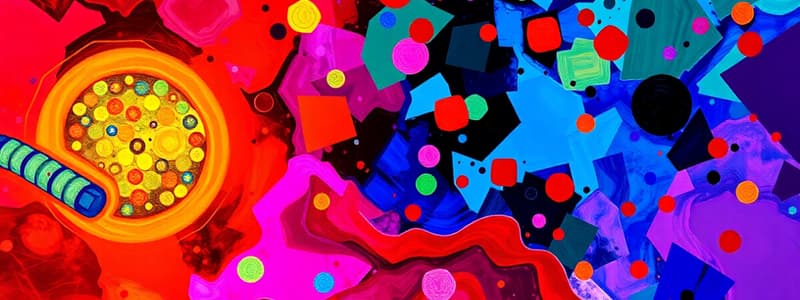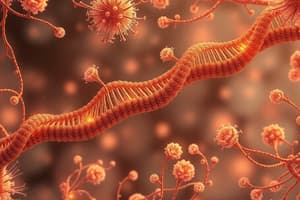Podcast
Questions and Answers
What is the primary function of the tryptophan repressor in gene expression?
What is the primary function of the tryptophan repressor in gene expression?
- To facilitate RNA transcription during amino acid scarcity
- To prevent RNA polymerase from binding to the promoter (correct)
- To degrade excess tryptophan in the cell
- To enhance transcription in the presence of tryptophan
Under what condition does the tryptophan repressor fall off the operator sequence?
Under what condition does the tryptophan repressor fall off the operator sequence?
- When there is an abundance of the repressor protein
- When tryptophan becomes scarce in the cell (correct)
- When RNA polymerase is actively transcribing
- When the promoter is inactive
What type of regulation does the binding of the tryptophan repressor to the operator represent?
What type of regulation does the binding of the tryptophan repressor to the operator represent?
- Facilitative control
- Conditional control
- Negative control (correct)
- Positive control
What happens to the repressor protein when a ligand, such as tryptophan, binds to it?
What happens to the repressor protein when a ligand, such as tryptophan, binds to it?
Which of the following statements about the tryptophan operon is true when tryptophan levels are high?
Which of the following statements about the tryptophan operon is true when tryptophan levels are high?
Which of the following best describes the mechanism of the tryptophan repressor?
Which of the following best describes the mechanism of the tryptophan repressor?
What is the role of operons like the tryptophan operon in prokaryotic cells?
What is the role of operons like the tryptophan operon in prokaryotic cells?
In the context of genetic regulation, what do activators do?
In the context of genetic regulation, what do activators do?
What role does the Gal-4 protein play in transcription?
What role does the Gal-4 protein play in transcription?
How do gene-regulatory proteins change from one gene to another?
How do gene-regulatory proteins change from one gene to another?
What is the significance of DNA looping in transcription?
What is the significance of DNA looping in transcription?
What happens when a chimera is formed by combining Gal-4 and LexA domains?
What happens when a chimera is formed by combining Gal-4 and LexA domains?
In bacterial transcription, what is the role of the activator?
In bacterial transcription, what is the role of the activator?
What is meant by the term 'holoenzyme' in the context of transcription?
What is meant by the term 'holoenzyme' in the context of transcription?
Which statement accurately describes regulatory sequences in eukaryotic genes?
Which statement accurately describes regulatory sequences in eukaryotic genes?
What process does the binding of a gene-regulatory protein trigger?
What process does the binding of a gene-regulatory protein trigger?
What leads to the increase in expression of the tyrosine aminotransferase gene?
What leads to the increase in expression of the tyrosine aminotransferase gene?
Which of the following statements about gene expression in multicellular organisms is true?
Which of the following statements about gene expression in multicellular organisms is true?
What could happen to the expression of the tyrosine aminotransferase gene when glucocorticoid levels decrease?
What could happen to the expression of the tyrosine aminotransferase gene when glucocorticoid levels decrease?
How many genes does each human cell typically express?
How many genes does each human cell typically express?
What is a key reason for the differences in function and appearance of cells in the same organism?
What is a key reason for the differences in function and appearance of cells in the same organism?
What role do external signals play in the regulation of gene expression?
What role do external signals play in the regulation of gene expression?
Which of these proteins is specifically abundant in muscle cells?
Which of these proteins is specifically abundant in muscle cells?
What is essential for cells to maintain their specific functions and respond to various signals?
What is essential for cells to maintain their specific functions and respond to various signals?
What role does the activator play in prokaryotic gene regulation when a ligand is present?
What role does the activator play in prokaryotic gene regulation when a ligand is present?
How does the position of the operator sequence influence the function of the lambda protein?
How does the position of the operator sequence influence the function of the lambda protein?
What distinguishes eukaryotic gene regulation from prokaryotic regulation?
What distinguishes eukaryotic gene regulation from prokaryotic regulation?
What is a primary challenge eukaryotic gene regulation faces compared to prokaryotic systems?
What is a primary challenge eukaryotic gene regulation faces compared to prokaryotic systems?
How does DNA structure play a role in transcription regulation in eukaryotes?
How does DNA structure play a role in transcription regulation in eukaryotes?
In the context of prokaryotic gene regulation, what happens when the ligand is removed from the activator?
In the context of prokaryotic gene regulation, what happens when the ligand is removed from the activator?
What mechanism allows eukaryotic transcription factors to regulate gene expression?
What mechanism allows eukaryotic transcription factors to regulate gene expression?
What is a consequence of the tight chromatin structure in eukaryotes?
What is a consequence of the tight chromatin structure in eukaryotes?
What must occur for the transcriptional machinery to access the DNA?
What must occur for the transcriptional machinery to access the DNA?
Which of the following is NOT a mechanism of chromatin remodeling?
Which of the following is NOT a mechanism of chromatin remodeling?
What effect does histone acetylation have on chromatin structure?
What effect does histone acetylation have on chromatin structure?
How does a repressor bind to prevent gene activation?
How does a repressor bind to prevent gene activation?
What is one way a repressor can recruit chromatin remodeling complexes?
What is one way a repressor can recruit chromatin remodeling complexes?
What must happen to some proteins for them to become active?
What must happen to some proteins for them to become active?
What does the recruitment of a histone deacetylase to the promoter region do?
What does the recruitment of a histone deacetylase to the promoter region do?
Which statement regarding the activation of gene-regulatory proteins is true?
Which statement regarding the activation of gene-regulatory proteins is true?
Flashcards are hidden until you start studying
Study Notes
Gene Expression: Different Cells, Same Genome
- Despite having the same genome, different cell types like neurons and lymphocytes have distinct functions and appearances due to differential gene expression.
- Cells express only a subset of their genes at any given time, allowing specific tasks within an organism.
- Cells can dynamically change the expression of their genes in response to external signals. For example, during starvation or intense exercise, the release of glucocorticoids causes the liver to convert amino acids into glucose. This leads to an increase in the expression of the gene coding for tyrosine aminotransferase, which helps convert tyrosine into glucose.
Variability in Gene Expression
- Many processes are common across all cells, such as the production of structural proteins, DNA and RNA polymerases, and enzymes essential for metabolism.
- Some proteins are highly specialized and abundant in specific cell types, like keratin in surface epithelial cells, hemoglobin in erythrocytes, and muscle fibers in muscle cells.
- Each human cell expresses between 10,000 and 20,000 genes out of the approximate 25,000 genes in the human genome, and the expressed genes vary between cell types.
Prokaryotic Gene Regulation: Operons and Repressors
- The tryptophan operon in bacteria represents a group of genes (open reading frames) controlled by one single promoter, regulating the biosynthesis of tryptophan.
- The tryptophan repressor is a DNA-binding protein that binds to the operator sequence located within the promoter, effectively blocking RNA polymerase from transcribing the operon.
- The repressor binds to the operator only in the presence of tryptophan, acting as a negative regulator of gene expression. When tryptophan is abundant, the repressor binds to the operator, preventing gene expression. When tryptophan is scarce, the repressor detaches from the operator, allowing transcription.
Negative and Positive Regulation
- Negative regulation is mediated by repressors, which modulate gene expression by binding to the operator sequence.
- Repressors can either bind only in the absence of a ligand and disassociate when the ligand binds or bind only in the presence of a ligand and detach when the ligand is removed.
- Positive regulation is mediated by activators, which can stimulate RNA polymerase binding to the operator.
- Activators can either bind to the operator only in the absence of a ligand or only when the ligand is bound to the operator sequence.
Eukaryotic Gene Regulation: More Complex and Dynamic
- Eukaryotic cells use a more complex array of transcription factors compared to bacteria, requiring a more elaborate mechanism for regulating gene expression.
- To overcome promoter crowding, eukaryotic gene regulatory proteins can act thousands of nucleotides away from the transcriptional start site.
- DNA bending and looping facilitate the interaction of regulatory proteins with the transcriptional machinery, allowing for a large number of regulatory elements to control a single gene.
Enhancers and Activators
- Activators can bind to enhancer sequences, which are located upstream of the promoter, and facilitate gene expression by promoting RNA polymerase recruitment through DNA bending.
- Eukaryotic gene regulatory proteins recognize and bind to specific DNA binding sites, enabling gene expression by recruiting RNA polymerase and other transcription factors.
Chromatin Remodeling
- Chromatin remodeling is essential for the accessibility of DNA to the transcriptional machinery.
- This can be achieved through two main mechanisms:
- Chromatin remodeling complexes, which alter nucleosome positioning.
- Histone acetylation by histone acetyltransferases (HATs), which loosens chromatin structure.
Repression of Gene Expression in Eukaryotes
- There are five known mechanisms for eukaryotic gene repression:
- Repressors bind to DNA binding sites, preventing activator binding.
- Repressors bind to the activation domain of nearby activators, inhibiting their activity.
- Repressors interact with transcription factors, preventing the binding of the holoenzyme to the promoter.
- Repressors recruit chromatin remodeling complexes, which condense chromatin and hide the promoter sequence.
- Repressors attract histone deacetylases, which remove acetyl groups from histones, promoting tighter chromatin structure and preventing TFIID binding.
Activating Gene Regulatory Proteins
- Gene regulatory proteins can be activated through various mechanisms:
- Some proteins are only synthesized when needed and rapidly degraded inside the cell.
- Others require binding to a specific ligand to become active.
- Certain proteins must be phosphorylated to become active.
Studying That Suits You
Use AI to generate personalized quizzes and flashcards to suit your learning preferences.




